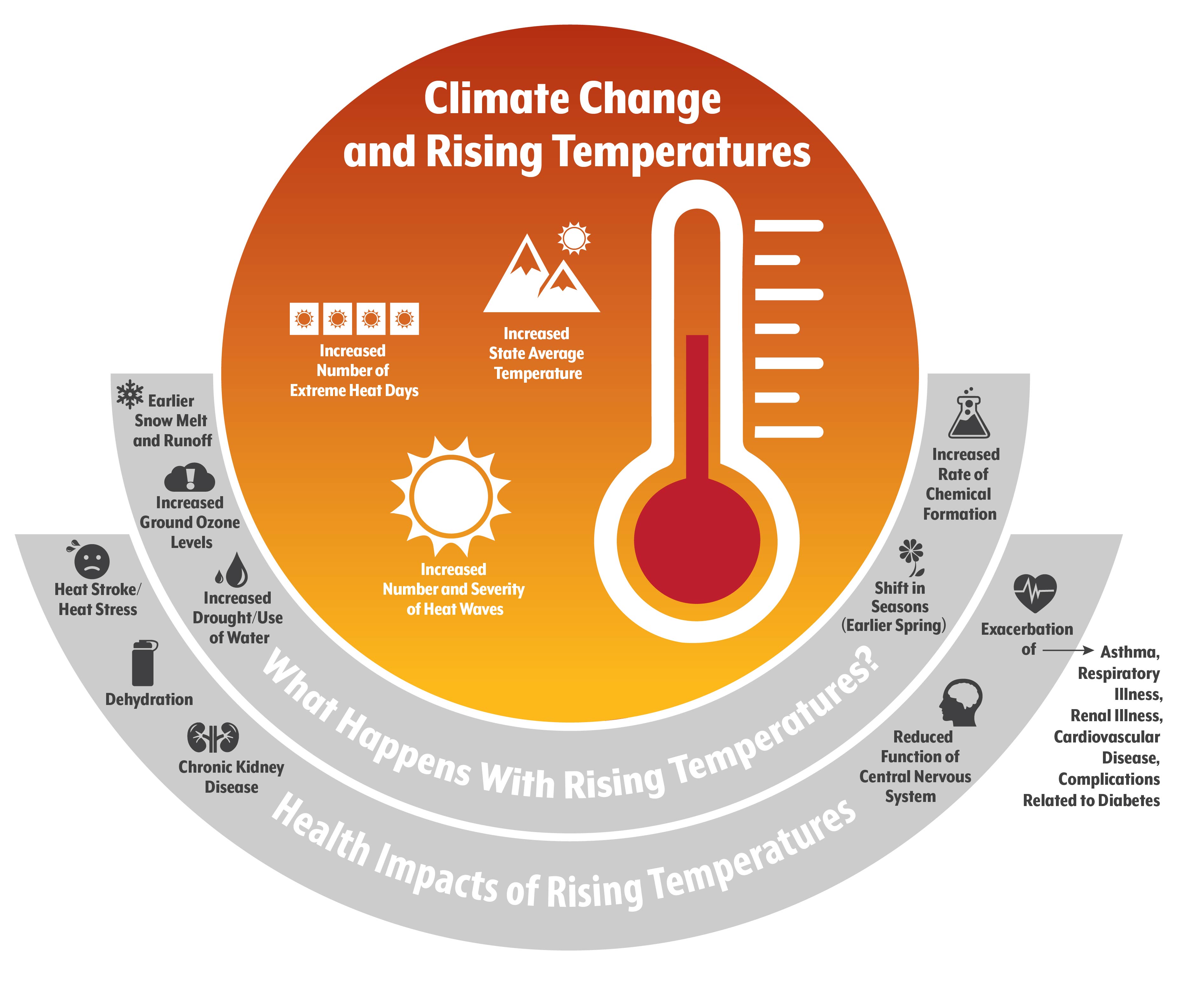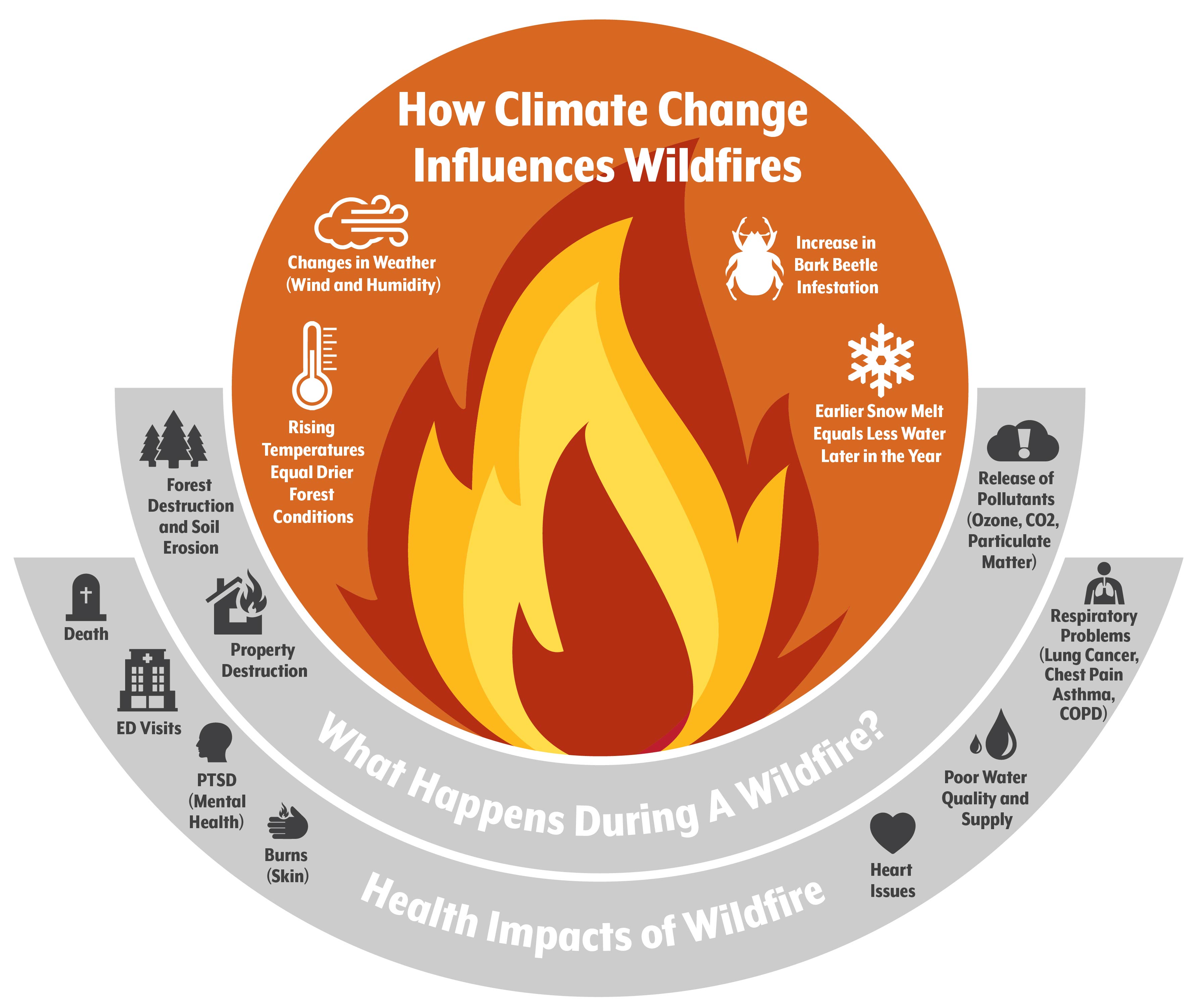1 National Aeronautics and Space Administration (NASA). (February 2005). “What’s the Difference Between Weather and Climate?” https://www.nasa.gov/mission_pages/noaa-n/climate/climate_weather.html
2 The Interagency Working Group on Climate Change and Health. (April 2010) “A Human Health Perspective on Climate Change.” Pg. 2. Environmental health Perspectives and the national Institute of Environmental Health Sciences. Available at: http://www.niehs.nih.gov/health/materials/a_human_health_perspective_on_climate_change_full_report_508.pdf
3 Excessive Heat Event Guidebook. (October 2016) Pg. 3. Environmental Protection Agency. Available at: https://www.epa.gov/sites/production/files/2016-10/documents/extreme-heat-guidebook.pdf
4 Delwiche, Jake. (2010). “After the Fire, Follow the Nitrogen.” University of Nebraska — Lincoln. Avilable at: http://digitalcommons.unl.edu/cgi/viewcontent.cgi?article=1079&context=jfspbriefs
5 Toxic Substances Portal for Nitrate and Nitrite. (September 2015). Agency for Toxic Substances and Disease Registry. https://www.atsdr.cdc.gov/toxfaqs/tf.asp?id=1186&tid=258
6 Colorado Climate Plan. (2015). “Chapter 3.3.1: Ozone and 3.3.2: Particulate Matter.” Pg. 20. https://www.codot.gov/programs/environmental/Sustainability/colorado-climate-plan-2015
7 The World Health Organization. Ambient (outdoor) Air Quality and Health (September 2016). Available at http://www.who.int/mediacentre/factsheets/fs313/en/
8 The USGS Water Science School. (2016). “Turbidity.” https://water.usgs.gov/edu/turbidity.html
9 NASA. (February 2015). “What’s the Difference Between Weather and Climate?”
10 The Impacts of Climate Change on Human Health in The United States. (2016). “Chapter 1 Introduction: Climate Change and Human Health.” https://s3.amazonaws.com/climatehealth2016/low/ClimateHealth2016_01_Introduction_small.pdf
11 Lukas, Jeff, et. al. (August 2014). “Climate Change in Colorado.” Pg. 2. Available at: http://cwcbweblink.state.co.us/WebLink/ElectronicFile.aspx?docid=191995&searchid=e3c463e8-569c-4359-8ddd-ed50e755d3b7&dbid=0
12 Lukas, J. et. al. (August 2014) pg. 2
13 Tebaldi, C. et. al. (June 2012). “The Heat is On, Climate Central.” Pg. 5. Climate Central. Available at: http://www.climatecentral.org/wgts/heat-is-on/HeatIsOnReport.pdf
14 Hayhoe, K. et. al. (2013). Graphic: “1700 Years of Temperature Change from Proxy Data.” National Climate Assessment. Available at: https://data.globalchange.gov/report/nca3/chapter/appendix-climate-science-supplement/figure/1700-years-of-global-temperature-from-proxy-data
15 American Public Health Association. (2017). “Climate Change.”
https://www.apha.org/topics-and-issues/climate-change
16 Global Environmental Outlook. (2016). “Regional Assessment for North America.” United Nations Environment Program Pg. 132. Available at: http://www.unep.org/geo/sites/unep.org.geo/files/documents/geo_assesment_north_america_november_2016.pdf
17 University of Colorado Boulder. Environmental Center. Impacts in Colorado. Available at: http://www.colorado.edu/ecenter/energyclimate-justice/general-energy-climate-info/climate-change/impacts-colorado
18 Colorado Climate Center. Drought Resources. Available at:
http://climate.colostate.edu
19 Centers for Disease Control and Prevention. “Climate Change and Extreme Heat Events.” Available at: https://www.cdc.gov/climateandhealth/pubs/ClimateChangeandExtremeHeatEvents.pdf
20 Coupled Modeling Intercomparison Project Phase 5 (CMIP5) Projections. Available at: http://cmip-pcmdi.llnl.gov/cmip5/
21 Lukas, J. et. al. (August 2014)
22 National Weather Service. “Summer Temperatures for Denver.” National Oceanic and Atmospheric Administration. Available at: http://www.weather.gov/Bou/DenverSummerTemperatureStatistics
23 Centers for Disease Control and Prevention. “Climate Change and Extreme Heat Events.”
24 NOAA’s Western Water Assessment Team. (2016). “Climate Change and Projections.” http://wwa.colorado.edu/climate/change.html
25 National Oceanic and Atmospheric Administration. (August 2014). “Future Temperature and Precipitation Change.” https://www.climate.gov/news-features/featured-images/future-temperatur…
26 U.S. Climate Data. (2017). “Climate Pueblo – Colorado.” Available at: http://www.usclimatedata.com/climate/pueblo/colorado/united-states/usco0323
27 United States Environmental Protection Agency. (August 2016). “What Climate Change Means for Colorado.” Available at:
https://www.epa.gov/climatechange/Downloads/impacts-adaptation/climate-change-CO.pdf
27 United States Environmental Protection Agency. (August 2016). “What Climate Change Means for Colorado.” Available at https://nepis.epa.gov/Exe/ZyPURL.cgi?Dockey=P100QV8O.txt
28 Centers for Disease Control and Prevention. (June 2016) “Managing Diabetes in the Heat.” https://www.cdc.gov/features/diabetesheattravel/
29 Public Health Institute: Center for Climate Change and Health. (2016) “Extreme Heat, Climate Change and Health.” http://climatehealthconnect.org/wp-content/uploads/2016/09/ExtremeHeat.pdf
30 AirNow. (September 2014). “Good Up High Bad Nearby – What is Ozone?” https://cfpub.epa.gov/airnow/index.cfm?action=gooduphigh.index
31 Ozone Aware. “Here’s the Dirt on Ground-Level Ozone.” http://ozoneaware.org
32 American Lung Association. (2016). “Most Polluted Cities.” http://www.lung.org/assets/documents/healthy-air/state-of-the-air/sota-2016-full.pdf
33 American Lung Association. (2017). “Most Polluted Cities.” Available at: http://www.lung.org/our-initiatives/healthy-air/sota/city-rankings/most-polluted-cities.html?referrer=http://www.lung.org/our-initiatives/healthy-air/sota/city-rankings/states/understanding-the-grades-and-tables.html
34 American Lung Association. “Healthy Air: Ozone.” http://www.lung.org/our-initiatives/healthy-air/outdoor/air-pollution/ozone.html#wheredoes
35 American Lung Association. (2017). “State of the Air 2017” – Fort
Collins, CO. http://www.lung.org/our-initiatives/healthy-air/sota/city-rankings/msas/fort-collins-co.html#ozone
36 American Lung Association. (2017). “State of the Air: 2017 – Denver-Aurora, CO.” http://www.lung.org/our-initiatives/healthy-air/sota/city-rankings/msas/denver-aurora-co.html#ozone
37 Colorado Department of Public Health and Environment. (2017). “Ozone information.” Available at: https://www.colorado.gov
38 Colorado Department of Public Health and Environment. (November 2016). “Ozone State Implementation Plan.” Available at: https://raqc.egnyte.com/dl/q5zyuX9QC1/FinalModerateOzoneSIP_2016-11-29.pdf_
39 EPA, Ozone NAAQS Timelines (2017). Available at: https://www.epa.gov/ozone-pollution/ozone-naaqs-timelines
40 Colorado Department of Public Health and Environment: “EPA lowers federal ozone standard; Colorado, other states face more difficult compliance.” (2015). Available at: https://www.colorado.gov/cdphe/news/ozone
41 The Denver Post. “Colorado, failing to meet smog standard, faces tougher limit” (2015). Available at: http://www.denverpost.com/2015/10/01/colorado-failing-to-meet-smog-standard-faces-tougher-limit/
42 EPA, Ozone NAAQS Timelines (2017). Available at: https://www.epa.gov/ozone-pollution/ozone-naaqs-timelines
43 The Impacts of Climate Change on Human Health in The United States. Chapter 3: Air Quality Impacts. (2016). Pg. 72. Available at: https://s3.amazonaws.com/climatehealth2016/low/ClimateHealth2016_03_Air_Quality_small.pdf
44 American Lung Association. “Report Card: Colorado, Groups at Risk” (2017). Available at http://www.lung.org/our-initiatives/healthy-air/sota/city-rankings/stat…
45 Colorado Climate Vulnerability Study: A report submitted to the Colorado Energy Office (2015). Chapter 10: Public Health Sector, Pg. 151. Available at: http://wwa.colorado.edu/climate/co2015vulnerability/co_vulnerability_report_2015_final.pdf
46 Climate Change in Colorado: A Synthesis to Support Water Resources Management and Adaptation (2014). Chapter 2: “The Observed Record,” Pg. 34. Available at: http://cwcbweblink.state.co.us/WebLink/ElectronicFile.aspx?docid=191995&searchid=e3c463e8-569c-4359-8ddd-ed50e755d3b7&&dbid=0
47 Climate Change in Colorado: A Synthesis to Support Water Resources Management and Adaptation (2014). “Executive Summary:” Pg.4. Available at: http://wwa.colorado.edu/climate/co2014report/Climate_Change_CO_Report_2014_FINAL.pdf
48 Report on The Health of Colorado’s Forests: Fire and Water (2016). Pg 15. https://csfs.colostate.edu/media/sites/22/2017/02/CSU_304464_ForestReport-2016-www.pdf
49 Climate Change in Colorado: A Synthesis to Support Water Resources Management and Adaptation (2014). Chapter 2: “Observed Record,” Pg. 35. Available at: http://cwcbweblink.state.co.us/WebLink/ElectronicFile.aspx?docid=191995&searchid=e3c463e8-569c-4359-8ddd-ed50e755d3b7&&dbid=0
50 The Denver Post. “Colorado wildfires, major fires from 1971-2013:” Interactive graphic. Available at: http://www.denverpost.com/2014/06/07/colorado-wildfires-major-fires-from-1971-2013-interactive-graphic/
51 Public Health Institute/Center for Climate Change and Health. Chapter 7.3: “Wildfires, Climate Change, and Health” (2016). Available at: http://climatehealthconnect.org/wp-content/uploads/2016/09/Wildfires.pdf
52 Wildfire Today. “Smoke from fire in Washington creating concern in Montana” (2015). Available at: http://wildfiretoday.com/2015/08/02/smoke-from-fire-in-washington-creat…
53 Colorado State University Extension. “Soil Erosion After Wildfire.” Available at: http://extension.colostate.edu/soil-erosion-control-after-wildfire-6-308/
54 Colorado Water Plan. Chapter 4: “Water Supply, Section Variability in Water Supplies,” Pg. 5. Available at: http://cwcbweblink.state.co.us/WebLink/ElectronicFile.aspx?docid=199502&searchid=80d50cb3-95bf-405c-bfa5-587c633c7136&dbid=0
55 Public Health Institute/Center for Climate Change and Health. Chapter 7.3: “Wildfires, Climate Change, and Health” (2016). Available at: http://climatehealthconnect.org/wp-content/uploads/2016/09/Wildfires.pdf
56 Public Health Institute/Center for Climate Change and Health. Chapter 7.3: “Wildfires, Climate Change, and Health” (2016). Available at: http://climatehealthconnect.org/wp-content/uploads/2016/09/Wildfires.pdf
57 Report on the Health of Colorado’s Forests. “Fire and Water.”(2016). Pg. 4. Available at: https://csfs.colostate.edu/media/sites/22/2017/02/CSU_304464_ForestReport-2016-www.pdf
58 American Lung Association. “People at Risk” (2017). Available at: http://www.lung.org/our-initiatives/healthy-air/sota/key-findings/people-at-risk.html#peopleasthma
59 Colorado Energy Office. “Renewable Energy Standard” (2017). Available at: https://www.colorado.gov/pacific/energyoffice/renewable-energy-standard
60 Colorado Rural Electric Association. “List of Electric Co-ops.” Available at: http://crea.coop/electric-co-ops-2/
61 Colorado Climate Change Plan (2015). Chapter 1, Section 2. Pg.3. Available at: http://cwcbweblink.state.co.us/WebLink/ElectronicFile.aspx?docid=196541&searchid=243b8969-739b-448c-bd2d-699af9b7aea0&dbid=0
62 Colorado Climate Action Plan (2007). “Executive Summary: Reduce Greenhouse Gas Emissions.” Pg 3. Available at: http://sciencepolicy.colorado.edu/students/envs_4100/ritter_2007.pdf
63 Mayors National Climate Action Agenda, Cities Climate Action Compendium (2017). Available at: http://www.climate-mayors.org/cities-climate-action-compendium/#block-yui_3_17_2_8_1464797356698_46219
64 City of Fort Collins, ClimateWise (2017). Available at:
https://www.fcgov.com/climatewise/about.php
65 City of Fort Collins, ClimateWise. “2015 Operations Report.” Available at: https://www.fcgov.com/climatewise/pdf/2015_cw_operationsreport.pdf
66 Colorado State Legislature (2013) House Bill 13-1293. Available at: http://www.leg.state.co.us/clics/clics2013a/csl.nsf/fsbillcont/FD5B92C7D67F90F787257AEE0058A740?Open&file=1293_enr.pdf







